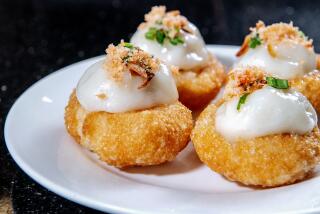The giant yucca’s edible bounty: seeds, fruit, even flowers
- Share via
The giant yucca certainly lives up to its name: Yucca gigantea rises 30 feet high in ideal conditions, with white blossoms that push out from the center -- flor de izote, as the bloom is sometimes called, the national flower of El Salvador.
Many species of yucca produce edible flowers, but the giant yucca also is prized for its ornamental qualities. As the plant gets older, the base of the grayish trunk swells, taking on the primeval look of an elephant’s foot. The stalk that produces flowers will die back, but the plant will continue to send up new pups and side spears that will flower. With maintenance, a single giant yucca will produce a dramatic, thick stand of plants.
The flowers that emerged from the giant yucca at the Francis Avenue Community Garden in L.A. have already been harvested. The spring bloom usually comes around Easter, and the petals find their way into seasonal cooking. Gardeners from Central America and Mexico, where the plant originated, treasure the crunchy white blossoms in scrambled eggs, pupusas and tacos.
“They sell for $6 to $8 a pound,” said Fernando Larios, the garden’s caretaker. “The plant is finished for now, but it flowers three times a year.”
Like all yucca, gigantea is drought tolerant and easy to propagate from new pups, which come up at ground level. The plant attracts few pests but can be killed by rot that comes with over-watering.
All parts of the plant are useful: the smooth, spineless leaves for their fiber; the roots as a soap; the seeds, fruit and stem as food. The flowers are prized most, crisp and tasting somewhere between artichokes and asparagus. After removing the bitter center bulb containing unopened buds, the separated petals are boiled for five minutes. (Raw petals can also go in a salad, but sparingly.)
Mia Wasilevich and Pascal Baudar of Transitional Gastronomy use yucca flowers to create cuisine anchored by local wild food.
“It’s one of our favorite things to cook from, aside from acorn,” Wasilevich said. “It’s really versatile. I use the tender ones -- purple white with a reddish tip.
You can find Yucca gigantea at some nurseries; at Worldwide Exotics in Lake View Terrace, the plant is sold as Yucca elephantipes. In other places, you might find the same plant labeled Yucca guatemalensis.
Baudar harvests his flowers from a local wild species, Yucca whipplei. But unlike at the Francis Avenue Community Garden, in the places where he forages, the season is just getting started.
“I make a Lebanese jam with the petals, sugar and beet juice,” he said. He also pickles the unopened flower buds and sautes the petals in a little butter. “They taste like Belgium endive,” he said. Being from Belgium, he should know.
The Global Garden, our series looking at multicultural Los Angeles through the lens of its landscapes, appears here on Tuesdays. For an easy way to follow the L.A. scene, bookmark L.A. at Home and join us on Facebook, Twitter and Pinterest.






